Haohao Li
A Multi-view Dimensionality Reduction Algorithm Based on Smooth Representation Model
Oct 12, 2019
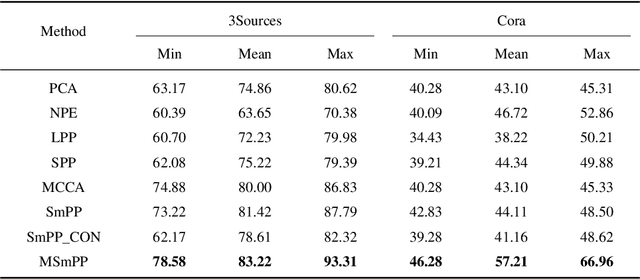


Abstract:Over the past few decades, we have witnessed a large family of algorithms that have been designed to provide different solutions to the problem of dimensionality reduction (DR). The DR is an essential tool to excavate the important information from the high-dimensional data by mapping the data to a low-dimensional subspace. Furthermore, for the diversity of varied high-dimensional data, the multi-view features can be utilized for improving the learning performance. However, many DR methods fail to integrating multiple views. Although the features from different views are extracted by different manners, they are utilized to describe the same sample, which implies that they are highly related. Therefore, how to learn the subspace for high-dimensional features by utilizing the consistency and complementary properties of multi-view features is important in the present. In this paper, we propose an effective multi-view dimensionality reduction algorithm named Multi-view Smooth Preserve Projection. Firstly, we construct a single view DR method named Smooth Preserve Projection based on the Smooth Representation model. The proposed method aims to find a subspace for the high-dimensional data, in which the smooth reconstructive weights are preserved as much as possible. Then, we extend it to a multi-view version in which we exploits Hilbert-Schmidt Independence Criterion to jointly learn one common subspace for all views. A plenty of experiments on multi-view datasets show the excellent performance of the proposed method.
Non-rigid 3D shape retrieval based on multi-view metric learning
Mar 20, 2019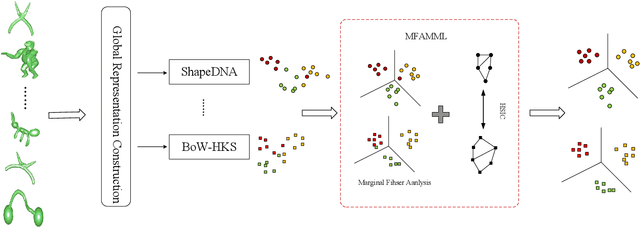

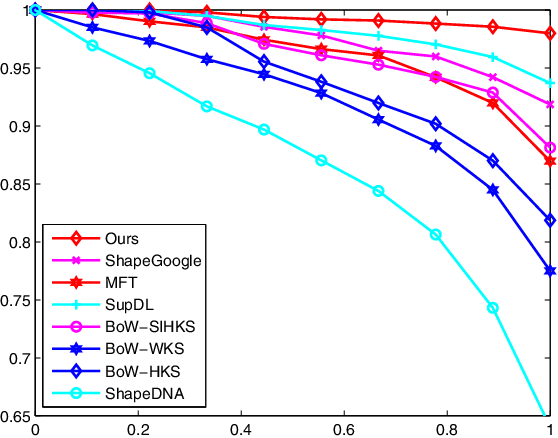
Abstract:This study presents a novel multi-view metric learning algorithm, which aims to improve 3D non-rigid shape retrieval. With the development of non-rigid 3D shape analysis, there exist many shape descriptors. The intrinsic descriptors can be explored to construct various intrinsic representations for non-rigid 3D shape retrieval task. The different intrinsic representations (features) focus on different geometric properties to describe the same 3D shape, which makes the representations are related. Therefore, it is possible and necessary to learn multiple metrics for different representations jointly. We propose an effective multi-view metric learning algorithm by extending the Marginal Fisher Analysis (MFA) into the multi-view domain, and exploring Hilbert-Schmidt Independence Criteria (HSCI) as a diversity term to jointly learning the new metrics. The different classes can be separated by MFA in our method. Meanwhile, HSCI is exploited to make the multiple representations to be consensus. The learned metrics can reduce the redundancy between the multiple representations, and improve the accuracy of the retrieval results. Experiments are performed on SHREC'10 benchmarks, and the results show that the proposed method outperforms the state-of-the-art non-rigid 3D shape retrieval methods.
Multi-feature Distance Metric Learning for Non-rigid 3D Shape Retrieval
Jan 10, 2019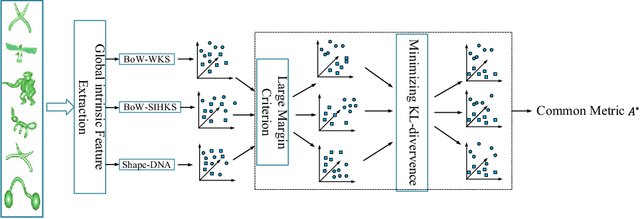

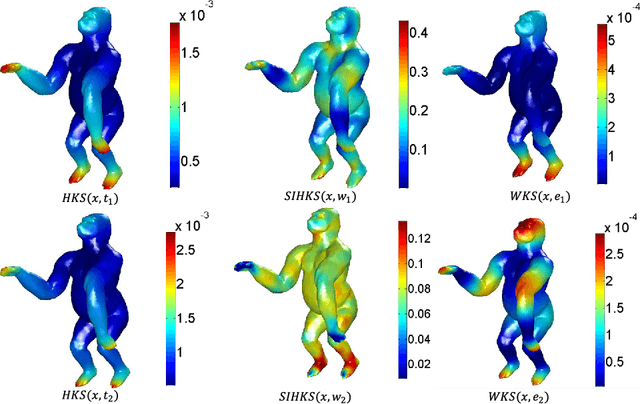
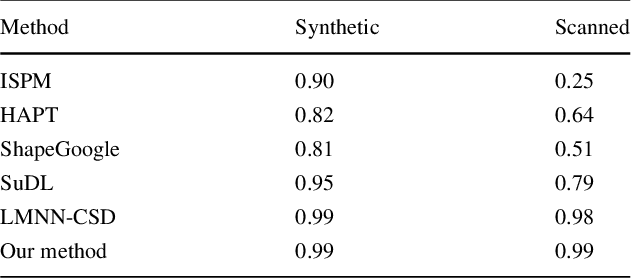
Abstract:In the past decades, feature-learning-based 3D shape retrieval approaches have been received widespread attention in the computer graphic community. These approaches usually explored the hand-crafted distance metric or conventional distance metric learning methods to compute the similarity of the single feature. The single feature always contains onefold geometric information, which cannot characterize the 3D shapes well. Therefore, the multiple features should be used for the retrieval task to overcome the limitation of single feature and further improve the performance. However, most conventional distance metric learning methods fail to integrate the complementary information from multiple features to construct the distance metric. To address these issue, a novel multi-feature distance metric learning method for non-rigid 3D shape retrieval is presented in this study, which can make full use of the complimentary geometric information from multiple shape features by utilizing the KL-divergences. Minimizing KL-divergence between different metric of features and a common metric is a consistency constraints, which can lead the consistency shared latent feature space of the multiple features. We apply the proposed method to 3D model retrieval, and test our method on well known benchmark database. The results show that our method substantially outperforms the state-of-the-art non-rigid 3D shape retrieval methods.
Auto-weighted Mutli-view Sparse Reconstructive Embedding
Jan 05, 2019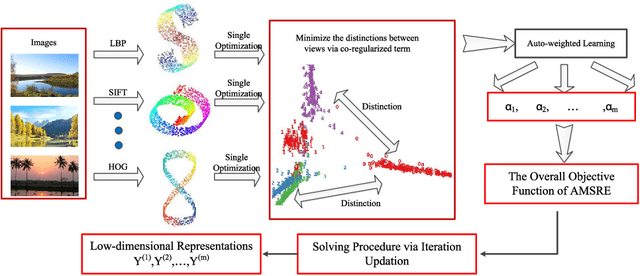
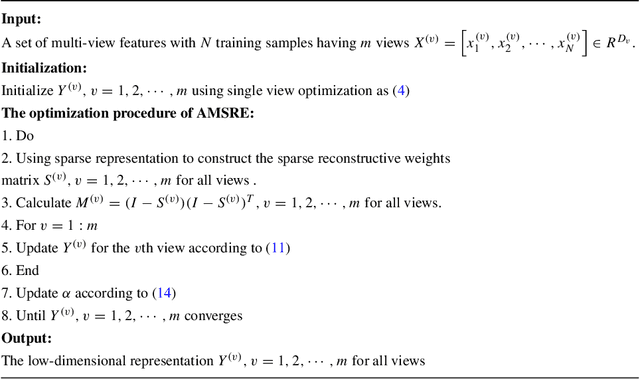
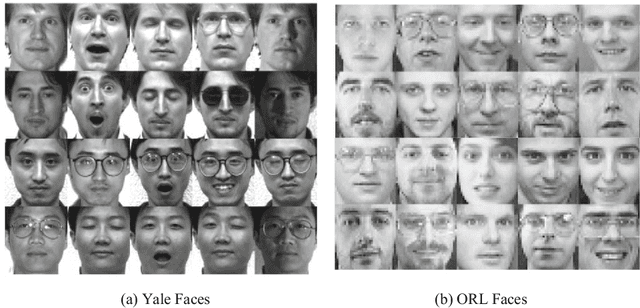

Abstract:With the development of multimedia era, multi-view data is generated in various fields. Contrast with those single-view data, multi-view data brings more useful information and should be carefully excavated. Therefore, it is essential to fully exploit the complementary information embedded in multiple views to enhance the performances of many tasks. Especially for those high-dimensional data, how to develop a multi-view dimension reduction algorithm to obtain the low-dimensional representations is of vital importance but chanllenging. In this paper, we propose a novel multi-view dimensional reduction algorithm named Auto-weighted Mutli-view Sparse Reconstructive Embedding (AMSRE) to deal with this problem. AMSRE fully exploits the sparse reconstructive correlations between features from multiple views. Furthermore, it is equipped with an auto-weighted technique to treat multiple views discriminatively according to their contributions. Various experiments have verified the excellent performances of the proposed AMSRE.
 Add to Chrome
Add to Chrome Add to Firefox
Add to Firefox Add to Edge
Add to Edge